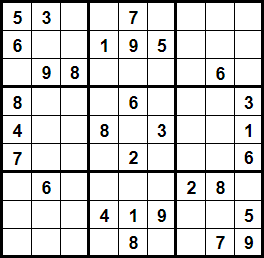LeetCode #37 Sudoku Solver
Write a program to solve a Sudoku puzzle by filling the empty cells.
Empty cells are indicated by the character ‘.’.
You may assume that there will be only one unique solution.
這題在旅行中嘗試解題,當初以為會像是自己解數獨題目哪樣單純,後來實際上跑測試資料才明白,有許多地方有多個選擇啊,原先寫的那套根本不能用……。
分析
先了解數獨規則,數字排列必滿足以下規則:
- 每一列 (row) 的數字必須包含 1-9,不能缺少也不能重複
- 每一行 (column) 的數字必須包含 1-9,不能缺少也不能重複
- 每一宮 (黑色框線區域,為 3x3 的九宮格)(box) 的數字必須包含 1-9,不能缺少也不能重複
如果每次挑出一空格,並展開完成該盤面的可能數字,嘗試展開所有解法路徑,可以畫成一個樹 (tree) 來思考:
其中必定存在一條從 root 到 leaf 的路徑,能將其盤面填滿,並且盤面上的所有數字,能滿足數獨的所有條件規則。(題目假設只有唯一解)
可以注意到的是,在決定空格能填什麼數字時,已經將不符合規則的數字排除,以減少後續的計算量 (即是 Pruning)。
在這次解法中並沒有建立額外記憶體空間,來儲存所有可能的正確解法 (因為題目考慮只有唯一解法),且採用遞迴函數 (recursive-function) 來找解法,因此如果發現該數字無法解答,會倒帶 (roll-back) 回去原本的狀態,然後繼續測試下一種可能。
解法
使用 Go:
import (
"context"
)
func solveSudoku(board [][]byte) {
solve(board)
}
func solve(board [][]byte) bool {
for x := 0; x < 9; x++ {
for y := 0; y < 9; y++ {
if board[x][y] == '.' {
ctx, cancel := context.WithCancel(context.Background())
for n := range possibles(board, x, y, ctx) {
board[x][y] = n
if solve(board) {
cancel() // Avoid goroutine leak
return true
} else {
board[x][y] = '.' // Roll back
}
}
return false
}
}
}
return true
}
func possibles(board [][]byte, x, y int, ctx context.Context) <-chan byte {
c := make(chan byte)
b := make([]bool, 10)
// Row
for xx := 0; xx < 9; xx++ {
if n := board[xx][y] - '0'; n < 10 {
b[n] = true
}
}
// Column
for yy := 0; yy < 9; yy++ {
if n := board[x][yy] - '0'; n < 10 {
b[n] = true
}
}
// Box
bx := (x / 3) * 3
by := (y / 3) * 3
for xx := 0; xx < 3; xx++ {
for yy := 0; yy < 3; yy++ {
if n := board[bx+xx][by+yy] - '0'; n < 10 {
b[n] = true
}
}
}
// Use channel to output numbers (iterator pattern)
go func() {
defer close(c)
for i := 1; i < 10; i++ {
if !b[i] {
select {
case c <- (byte)('0' + i):
case <-ctx.Done():
return
}
}
}
}()
return c
}












沒有留言: